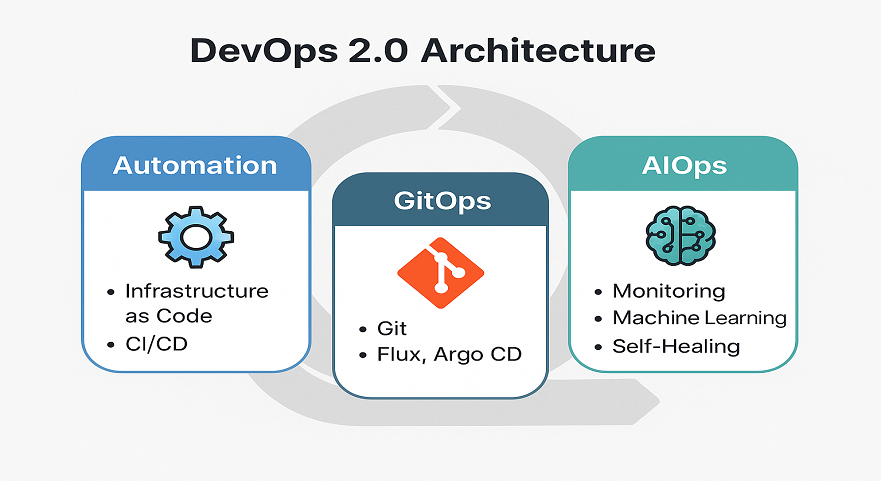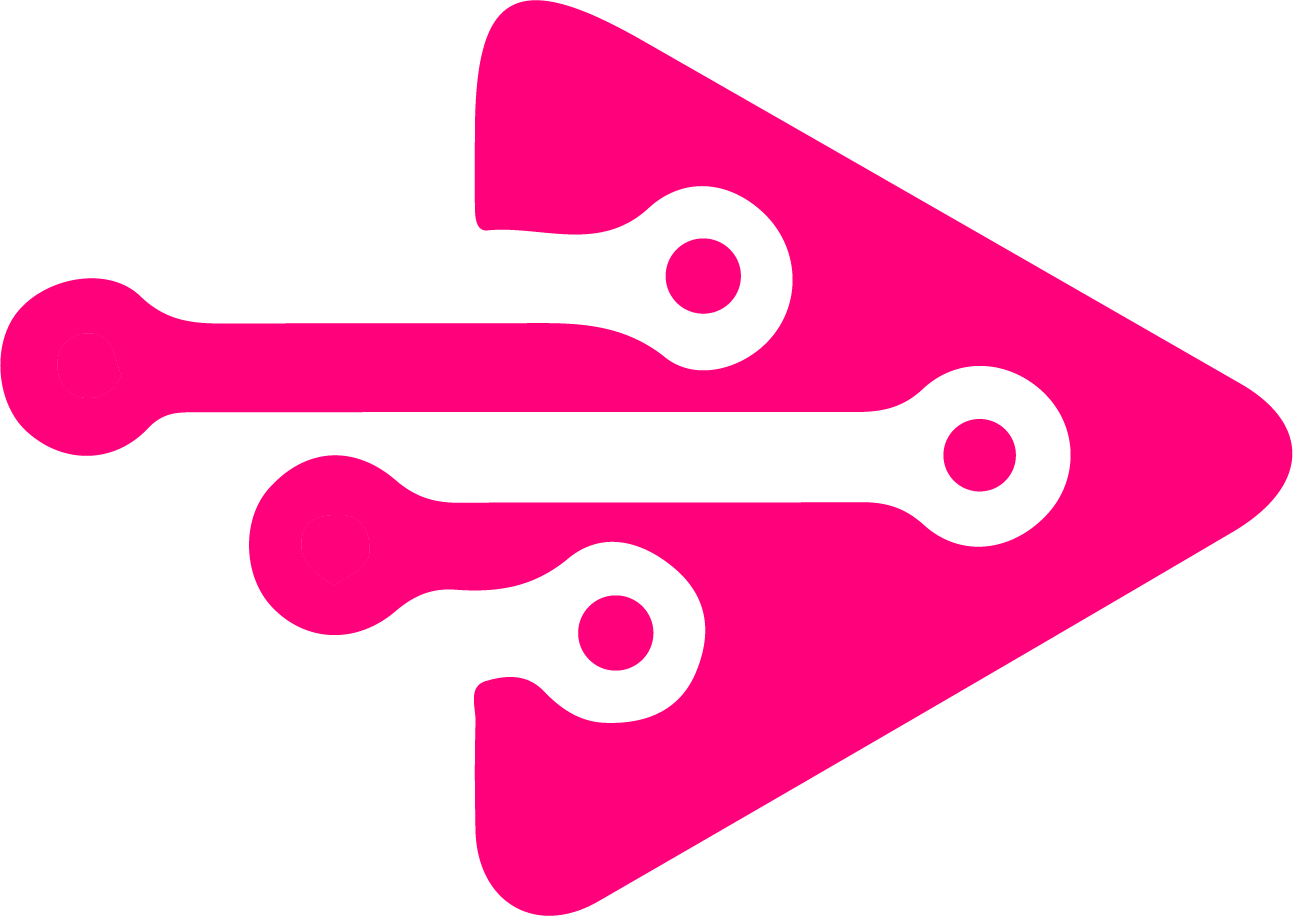DevOps 2.0: Automation, GitOps, and AI-Driven Operations

As digital transformation accelerates, software delivery teams are increasingly adopting advanced methodologies to streamline deployment pipelines, increase system reliability, and respond swiftly to business demands. DevOps 2.0 represents the evolution of traditional DevOps practices, incorporating automation, GitOps principles, and artificial intelligence (AI) to achieve a more scalable and intelligent operational model. This blog explores the key pillars of DevOps 2.0, their interconnection, and their impact on modern software engineering.
The Evolution from DevOps to DevOps 2.0
Traditional DevOps focuses on the collaboration between development and operations teams to break down silos, accelerate releases, and ensure system stability. However, as infrastructure scales and software ecosystems become more complex, conventional DevOps practices face limitations in visibility, speed, and consistency.
DevOps 2.0 extends the foundational principles by introducing higher degrees of automation, embracing Git as the single source of truth, and leveraging AI to proactively manage system behaviors. The goal is to create a self-regulating and resilient environment that minimizes human intervention while enhancing system efficiency.
Automation: The Backbone of DevOps 2.0
Infrastructure as Code (IaC)
Automation begins with Infrastructure as Code (IaC), which enables the provisioning and management of infrastructure using code-based templates. Tools like Terraform, AWS CloudFormation, and Ansible ensure consistent environments across development, testing, and production.
IaC reduces manual configuration errors and accelerates environment setup, making it foundational for CI/CD pipelines and disaster recovery scenarios.
Continuous Integration and Continuous Delivery (CI/CD)
Automation in CI/CD pipelines ensures that every code change is tested, built, and deployed seamlessly. Platforms such as Jenkins, GitLab CI, and GitHub Actions facilitate these automated workflows.
By automating unit tests, integration tests, and deployments, organizations reduce lead time for changes and improve release quality.
Policy-Driven Automation
Policy-as-code tools like Open Policy Agent (OPA) enforce compliance and governance automatically across infrastructure and applications. These tools enable teams to codify security and operational policies, thereby automating audit and compliance requirements.
GitOps: Version-Controlled, Declarative Operations
What is GitOps?
GitOps is a modern operating model that applies Git repositories as the single source of truth for declarative infrastructure and application deployments. Changes to systems are made through pull requests, triggering automated synchronization between the declared state in Git and the actual system state.
Benefits of GitOps
- Auditability: Every change is traceable, auditable, and reversible through Git history.
- Consistency: Environments remain synchronized through declarative definitions, reducing configuration drift.
- Developer Empowerment: Developers can manage infrastructure changes via Git workflows without relying on dedicated operations teams.
Popular tools supporting GitOps include Flux and Argo CD, which integrate seamlessly with Kubernetes to manage state reconciliation and automated rollbacks.
AI-Driven Operations: Intelligent Observability and Automation
Predictive Analytics and Anomaly Detection
AI-driven operations (AIOps) utilize machine learning algorithms to analyze logs, metrics, and traces for identifying patterns, predicting failures, and detecting anomalies. Platforms such as Dynatrace, Datadog, and Moogsoft apply real-time analytics to improve incident response and reduce Mean Time to Resolution (MTTR).
Root Cause Analysis and Self-Healing
Advanced AIOps platforms can automatically perform root cause analysis by correlating alerts across multiple systems. Combined with automated remediation scripts, this leads to self-healing systems that resolve common issues without human intervention.
Capacity Planning and Optimization
AI assists in forecasting usage trends and optimizing infrastructure utilization. Intelligent scaling mechanisms ensure resource efficiency while maintaining service availability, particularly in cloud-native architectures.
Integration and Challenges in Implementing DevOps 2.0
Integration Complexity
Merging automation, GitOps, and AIOps requires seamless integration of diverse tools and platforms. Ensuring compatibility, security, and scalability can pose significant challenges for enterprises.
Cultural and Skill Shifts
DevOps 2.0 demands a shift in mindset. Developers, operators, and security teams must align on shared goals, adopt Git-centric workflows, and build AI literacy to fully leverage the benefits.
Data Governance and Compliance
With increased automation and AI involvement, maintaining data integrity and regulatory compliance becomes critical. Organizations must implement robust data policies and ensure AI models operate within ethical boundaries.
The Road Ahead: Future of DevOps 2.0
The future of DevOps 2.0 lies in further decentralization, hyperautomation, and integration with platform engineering. With the rise of internal developer platforms (IDPs), teams can abstract complex infrastructure layers and provide self-service capabilities that further enhance productivity and operational excellence.
Additionally, the convergence of observability, AI, and edge computing will demand even more intelligent and decentralized operations strategies.
Conclusion
DevOps 2.0 signifies a paradigm shift toward more autonomous, reliable, and scalable software delivery. By combining automation, GitOps practices, and AI-driven insights, organizations can achieve faster innovation cycles while maintaining operational stability.
Enterprises aiming to stay competitive must invest in these emerging practices to future-proof their technology landscape. For expert guidance and implementation support in adopting DevOps 2.0 strategies, Tech i-vin Technology offers tailored solutions that align with industry standards and enterprise goals.
